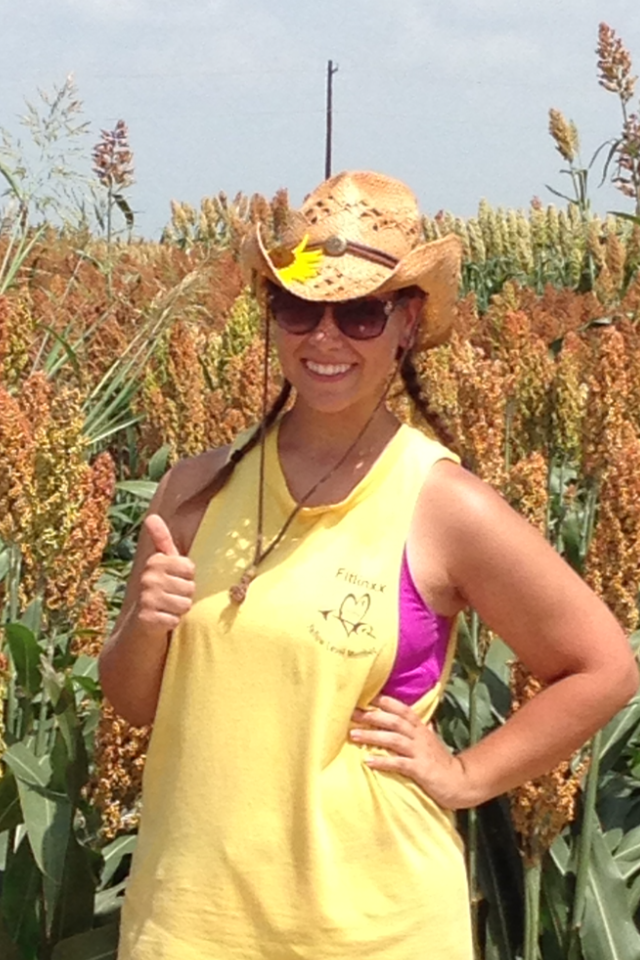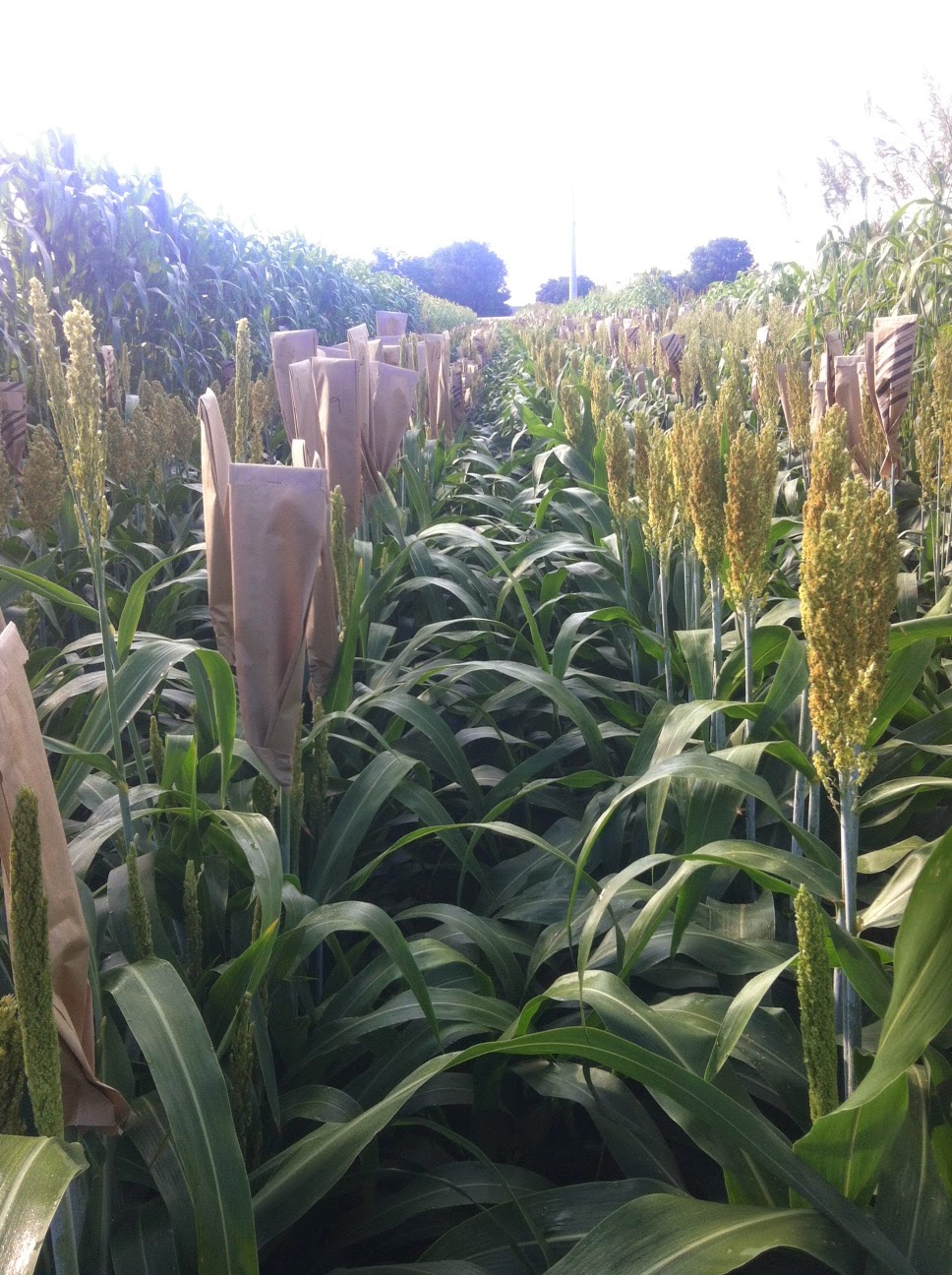Well, today is August 1 which means that my internship is
officially ending. The last two months flew by! It seems like last week that
the sorghum was only as high as my knees and we were doing anthracnose inoculations.
Now, some of the sorghum is nearly ten foot tall and it’s like tromping through
the jungle every time we walk into the field. This week we finished up helping
two of our grad students harvest and process their plants and next week begins the
harvesting of all the panicles that we crossed. I can only imagine what that’s
going to be like!
With this last official post of my internship, I wanted to
talk a bit about my thoughts on the whole thing, what my plans are now that it’s
ended, and definitely thank a few people. Firstly, without a doubt this has
been a positive experience. I’ve learned oodles of information about sorghum
and breeding, but also about graduate programs and research itself. I found out
about this program through one of my TAs, Ace, who was a grad student with Dr.
Rooney, and on a whim, I applied. I am so glad I did. Interning here cemented
my love of working outside and I’ve discovered that I really enjoy the science
of it all –what little I’m able to be a part of –enough so that I’m hoping to
possibly do research as a grad student once I graduate in May. Now on to the
thank yous.
Throughout my life I’ve worked many jobs and I’ve interacted
with all kinds of people, but I must say, the quality of people that work in sorghum
breeding here at A&M is tops. There’s not a bad apple in the whole bunch. It’s
rare to find a group like this where everyone is as hardworking and amiable as
they are.
 |
| Student workers |
Being a student worker, I spent most of my time with the
other student workers: Josh, Jon, Zac, and Paul. Without a doubt, these guys
have been a major influence on my opinion of my internship. They made every day
enjoyable and kept me laughing the whole time. Being the only girl in an all-boys
club was odd at first, but these guys are sweet sweet sweet! Not many people
would be down for singing show tunes in the sorghum, but sing they did! And not many people could be so exhausted and sleep
deprived as they are sometimes and still be nothing but kind and friendly. These
guys are gems, each and every one of them.
I also had quite a bit of interaction with the grad students:
Bethany, Brian, Ace, Geraldo, Francisco, Luke, and Lloyd. Every one of them is extremely
bright, but at the same time, completely down to earth. Interacting with the
grad students was intimidating at first, but they’re all so friendly and they’ve
been great about answering any questions that I may have. They put up with me
when I had no idea what I was doing (which was all the time at the beginning)
and were more than willing to help me out when they could. Also, it’s been a
wonderful opportunity for me to see the day in and day out of what it means to
be a grad student. They’re all passionate about what they’re doing and if you
even hint that you’d like to know more about their project, they’re happy to
explain –it’s clear that they enjoy what they do.
Next on my list of shout outs are Leo, our post-doc, and
Steve, our technician and jack of all trades. Without these two, the lab would
fall to pieces. Between the two of them, anything can be fixed, built, or invented.
They’re an integral part of the lab.
Vickie, the secretary and secretly the boss, somehow keeps
everything at the lab running smoothly. I have no idea how she does it, but she
manages to keep everything and everyone in line.
Next comes Delroy, our senior research associate and one of
my favorite people! He was actually the one who I interviewed with and for some
unknown reason, he decided to hire me, a horticulture major with no previous farming
history, who can’t even drive a standard transmission, and had no idea what sorghum
was… brave man. Delroy is really the backbone of the whole program. He’s been with
sorghum breeding for quite some time and is the person I report to –he’s in
charge of student workers. Delroy is probably the kindest person I’ve ever met
and has made my time with the sorghum program wonderful.
And last, but certainly not least, the commander-in-chief,
Dr. Bill Rooney. He’s the director of sorghum breeding here at A&M and is the
supreme being of this program. I was extremely intimidated by him at first; Dr.
Rooney is absolutely brilliant and is very well-known in this field. However,
he’s also one of the sweetest, down-to-earth people I know. I’ve never had a
boss who cared so much about the people who worked for him and who would sit
down and chew the fat while play dominos with everyone during the lunch hour.
All of his students are very loyal to him and for good reason. Dr. Rooney is a
huge part of why my internship was so enjoyable.
I’ve met so many outstanding people during my time here. It’s
been a blessing and a privilege to work alongside these guys and I’ve
definitely made friendships that will long outlast my internship.
.jpg) |
| Sorghumville |
Although the internship is finished, the work is not; we’re
right in the middle of harvesting so we have lots to do and not very much time
to do it. I’ll continue to work with this program throughout the rest of the
summer as well as for my senior year. Also, I’ve decided to keep the blog up
for the rest of the season –at least until we’ve harvested everything. It only makes
sense to continue until the end so that those who have kept up with what we’ve
been doing here in sorghum breeding can see the whole progression of things
from start to finish. Check back soon for an update on harvesting!
 |
| Gig 'em! |























